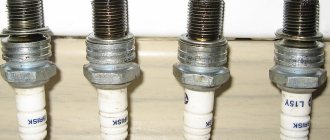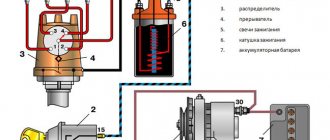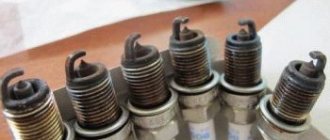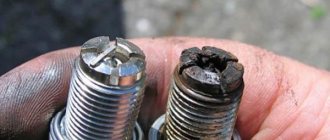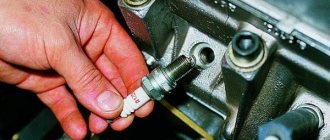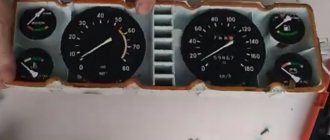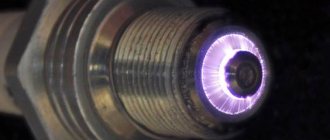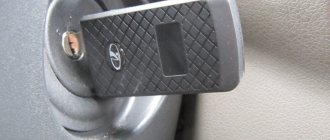Black carbon deposits on spark plugs, causes
Black carbon deposits on the electrodes and insulators are one of the most common spark plug problems.
Its appearance indicates certain problems in the operation of the car engine and its systems. In most cases, black soot is the remnants of an over-enriched fuel mixture that have not burned in the combustion chamber. Constant use of spark plugs with black soot leads to interruptions in their operation at best and complete failure at worst. This is reflected in engine operation by the appearance of dips and jerks, unstable idling (the engine “troits”), “shooting” at the muffler, loss of power and throttle response, and increased fuel consumption.
There are not so many reasons for the appearance of black carbon deposits on the spark plugs of a carburetor engine of a passenger car (for example, VAZ 2108, 2109, 21099, 2105, 2107). Below is a list of them in relation specifically to carburetor engines of VAZ 2108, 2109, 21099, 2105, 2107.
Reasons for the appearance of black carbon deposits on the spark plugs of a carburetor engine
— Reasons related to the carburetor and power system
Black carbon deposits on spark plugs are the result of a highly enriched fuel mixture, the residues from incomplete combustion of which are deposited on the electrodes and insulator of the spark plugs. This can lead to:
Increased fuel level in the carburetor float chamber (“overflow”)
The level is not adjusted correctly, the needle shut-off valve is not sealed, the float(s) are not sealed, the float(s) touches the walls of the float chamber, the fuel pump creates excess pressure (the drive pusher protrudes strongly).
Measuring the fuel level in the float chamber of the carburetor 2108, 21081, 21083 Solex
Measuring the protrusion of the VAZ fuel pump pusher
Wear or leakage of the power mode economizer ball valve
Excess fuel enters the engine not only in power modes, when the economizer should be turned on, but also in all other modes.
Economizer device for power modes of carburetor 2108, 21081, 21083 Solex
Clogged air jets of the main dosing systems
The fuel mixture becomes over-rich because not enough air is supplied to it.
Air jets, fuel jets, emulsion tubes and GDS wells of the Solex carburetor
The fuel mixture “quality” screw is not adjusted correctly
The adjustment was made in the direction of re-enrichment of the fuel mixture.
Screws for adjusting the “quality” and “quantity” of the fuel mixture of the Solex carburetor
The air filter is very dirty
In this case, the balance of fuel and air again shifts towards an excess of fuel.
Heavily contaminated car engine air filter element
— Reasons related to the ignition system
The ignition timing is not set correctly
Most likely the ignition is too early. The fuel mixture ignites too early and does not burn completely.
Ignition alignment mark on flywheel
The high-voltage wires, the cover or the “slider” of the distributor are “broken”
Current leakage through “broken” parts of the ignition system reduces the power of the spark or leads to its termination. The fuel mixture does not burn efficiently.
Ignition coil is faulty
The ignition coil may leak current through a crack in the cover. The consequences are similar to those described above.
The spark plugs themselves are faulty
The glow number of the spark plugs does not correspond to the engine, the gap between the spark plug electrodes is small, the spark plug is internally defective.
The listed malfunctions lead to interruptions in spark formation, a weak spark between the electrodes of the spark plugs and, accordingly, to poor and inefficient combustion of the fuel mixture. As a result, the engine “troubles” or does not start, the electrodes of the spark plugs are black.
— Reasons related to engine malfunction
Severe wear on piston rings
There is no compression in the cylinders on the compression stroke. Without the necessary pressure in the combustion chambers, the fuel mixture burns poorly and deposits black soot on the spark plugs.
Problems with the engine valve train
The valves are not sealed and their thermal clearances are not adjusted.
These reasons lead to inefficient combustion of the fuel mixture, its burning out in the intake manifold and, accordingly, the deposition of black deposits on the electrodes of the spark plugs.
Notes and additions
— If the engine and all its systems are operating normally, carbon deposits on the spark plugs are brown (the range of brown can be from light brown to dark brown).
FakeHeader
Comments 8
Candles with a whitish coating are a poor mixture, the skirt is black? What can happen to the engine if you drive on a lean mixture? Or is it a little depleted?! Could the lean mixture be due to the ignition?! Or is it just because of the carburetor?! With whitish spark plugs, the engine runs well and the dynamics are good! What should I do or leave it like this?! I read in the manual that when you turn off the engine there should be no shaking, shaking is a late ignition! So it shakes as it is considered when, after turning off the ignition, it wobbles, still continues to work, or just turned it off and the engine staggered when stopped?!
Please tell me, I read it in the manual! Now we connect our light bulb with one wire to the positive terminal of the ignition coil, and the second wire to ground. We remove the central wire of the coil from the distributor cover and fix it at a distance of approximately 1-5 mm from ground. This is done in order to prevent breakdown of the ignition coil to ground. What if you just pull the wire out from there and from there?! Do you have to do it as written?!
Most likely a lean mixture. the spark plug should be brown, but there is a ringing noise, either early ignition, knocking piston pins like mine, or detonation))
Do not get into the carburetor under any circumstances - it works great with spark plugs. and do the ignition later - when you are driving in fourth, there should be no ringing when accelerating hard. and memz likes late ignition - a little - a little.
First, check the level in the float chamber. Second, put cooler candles. third, it’s not the valves that are ringing, but the piston pins. Fourth, the gasoline may be bad. Fifth, don’t break the car and it will never let you down.
how are these colder candles?, this is the first time I’ve heard
lean mixture. ringing, most likely detonation. The color of the insulator should usually be “coffee with milk”. for the first chamber, increase the fuel and reduce the air; the second is similar, only reduce the air even more
Possible reasons for the appearance of soot
Before answering the question of why the candles are black, you need to decide how exactly they turned black . After all, it depends on which direction to search. In particular, the candles can turn black all together, or maybe only one or two of the set. Also, the candle may turn black only on one side, or perhaps along its entire diameter. There are also so-called “wet” and “dry” carbon deposits.
It should be noted that the speed of appearance and nature of carbon deposits directly depends on existing faults (if any):
- Carbon deposits on new spark plugs begin to form after at least 200-300 km. Moreover, it is advisable to drive along the highway at approximately the same speed and engine load. This way the spark plugs will work in optimal mode, and it will be possible to more objectively assess the condition of the car’s components.
- The amount and type of soot depends on the quality of the fuel used. Therefore, try to refuel at trusted gas stations, and not drive with gasoline or similar mixtures. Otherwise, it will be difficult to establish the real cause of the appearance of soot (if it occurs).
- In a carburetor engine, the idle speed must be set correctly.
Now let's move directly to the question of why black soot appears on the spark plugs. There may be 11 main reasons :
- If you notice blackening on only one side, then most likely this is caused by a burnt-out valve. That is, carbon deposits on the spark plug fall on the side electrode from below (and not on the central one).
- The cause of black spark plugs may be a burnt-out valve. The situation is similar to the previous one. Carbon deposits may penetrate the bottom electrode.
- An incorrectly selected glow rating of a spark plug causes not only damage to it during further use, but also uneven blackening at first. If the mentioned number is small, then the shape of the soot cone will change. If it is large, then only the top of the cone will turn black, and the body will be white.
“Dry” carbon deposits on a candle
As a rule, when the ignition is set late and the air-fuel mixture is rich, the following consequences arise:
- misfires (error P0300 appears on injection engines);
- problems starting the engine;
- unstable engine operation, especially at idle, and as a result, increased vibration levels.
Next, we will tell you how to eliminate the listed faults and how to clean the spark plugs.
Varieties of black soot
The black color indicates the presence of ordinary soot on the candle, that is, unburned amorphous carbon. It is produced by petroleum products and other organic matter that have failed to oxidize properly.
A more accurate assessment of the situation is determined by both the shades of color and the nature of its distribution over the working part of the candle. The appearance of any belts around the outer part of the insulator, located above the hexagon under the spark plug wrench, is usually not a cause for concern, although many auto repairmen mercilessly reject good spark plugs for this very reason. At the very least, this is not justified.
What to do if soot appears
First of all, it is necessary to remember that oil contamination and overheating, which results in soot on the spark plugs, are very harmful to the ignition system . Overheating is especially dangerous, since it causes the possibility of failure of the electrodes on the spark plugs without the possibility of their restoration.
If your car only has one blackened spark plug, you can diagnose the breakdown by simply swapping the spark plugs. If after this the new spark plug also turns black and the old one clears up, it means that the problem is not in the spark plugs, but in the cylinder. And if nothing has changed, then questions arise about the performance of the candle itself.
Oil deposits
In some cases, the candles may be wet and black. Most often, the reason for this fact is oil getting into the combustion chamber. Additional symptoms of this problem are as follows:
- difficulty starting the engine;
- omissions in the operation of the corresponding cylinder;
- the engine jerks during operation;
- the appearance of blue smoke from the exhaust.
Oil can enter the combustion chamber in two ways - from below or from above. In the first case, it enters through the piston rings. And this is a very bad sign, because it often threatens a major engine overhaul . In rare cases, you can get by with decoking the engine. If oil enters the combustion chamber through the top, it comes from the cylinder head along the valve guides. The reason for this is the wear of the valve stem seals. To eliminate this problem, you just need to select new, high-quality caps and replace them.
Carbon deposits on the insulator
Red carbon deposits on a candle
In some cases, carbon deposits that naturally appear in the combustion chamber can come off the piston at high engine speeds and stick to the spark plug insulator. The consequence of this will be gaps in the operation of the corresponding cylinder. The engine will “trouble” in this case. This is the most harmless situation why spark plugs turn black. You can eliminate it simply by cleaning their surface or replacing it with new ones.
If black and red spark plugs , this means that you are pouring fuel with an excessive amount of metal additives. It cannot be used for a long time because over time, metal deposits form a conductive coating on the surface of the spark plug insulator. Sparking will deteriorate and the spark plug will soon fail.
Cleaning spark plugs
Thorough cleaning
In severe cases, it will not be possible to clean the jets without removing the carb. Over time, debris accumulates in the carburetor chamber, causing the passages to become clogged and clogged.
Preparing for a thorough cleaning is called interfering with the position of the spark plug wires. Two armored wires are swapped (for example, the armored wire of cylinder 1 is placed in place of the wire of cylinder 4, and vice versa). The engine starts, with a terrible “shooting” and “sneezing” sound. This allows sediment to be automatically knocked out of the channels back into the chamber.
Cleaning spark plugs from deposits
Cleaning candles must be done regularly, as well as inspecting their condition. It is recommended to do this after approximately 8.10 thousand kilometers . It is very convenient to do this when changing the engine oil. However, if the symptoms described above occur, you can do this earlier.
it is not recommended to use the old method of using sandpaper to clean electrodes . The fact is that this creates a risk of damaging the protective layer on them. This is especially true for iridium spark plugs . Their central electrode is thin and coated with iridium, which is a semi-precious and rare metal.
To clean spark plugs you will need:
- detergent to remove plaque and rust;
- disposable plastic cups (after completion of the cleaning procedure they must be disposed of; they cannot be used for food products in the future);
- a thin brush with hard bristles or a toothbrush;
- rags.
The cleaning procedure is performed according to the following algorithm:
- The cleaning agent is poured into a glass prepared in advance to a level that completely immerses the spark plug electrodes (without an insulator).
- Immerse the candles in the glass and leave for 30-40 minutes (during the process, a chemical cleaning reaction occurs, which can be observed with the naked eye).
- After the specified time has elapsed, the candles are taken out of the glass, and using a brush or toothbrush, plaque is removed from the surface of the candle, especially paying attention to the electrodes.
- Wash the candles in warm running water, removing the chemical composition and dirt from their surface.
- After washing, wipe the candles dry with a rag prepared in advance.
- The final stage is to dry the candles on a radiator, in the oven (at a low temperature of +60...+70°C) or using a hairdryer or fan heater (the main thing is that the remaining water in them completely evaporates).
The procedure must be carried out carefully, cleaning and removing all dirt and plaque present on the surface. Remember that washed and cleaned candles are 10.15% more effective than dirty ones .
Results
The appearance of a black spark plug on a carburetor or injector can be caused by various reasons. As a rule, there are several of them at once . For example, incorrectly selected spark plugs, prolonged engine operation at high speeds, incorrectly set ignition, faulty valve stem seals, and so on. Therefore, we recommend that if the symptoms described above appear, you simply periodically check the condition of the spark plugs on your car.
This way you will not only extend the life of the engine, but also maintain power and driving comfort. You can see additional information on how you can diagnose a car engine by the color of spark plug soot.
Why do spark plugs fill with fuel?
First of all, you should understand why the spark plugs in the VAZ-2109 8 valves are filled with fuel. As statistics show, such a malfunction appears in cars most often with the onset of cold weather, and this is explained by the fact that when the temperature of the fuel-air mixture is below zero, much more effort is required for mixing. Since cool air contains more oxygen, gasoline consumption, especially for a cold car, increases several times.
- the electronic control unit transmits a command to the injector to increase gasoline consumption, and the injector, in turn, regularly carries out the received order;
- after this, a chemical process is started that heats the fuel-air mixture to the desired temperature.
According to experts, spark plugs are not filled with fuel in new VAZ-2109 cars. If such a malfunction does occur, in such a situation it is necessary to check the serviceability of the starter and make sure that the battery is being recharged with the required power. You should definitely “feed” your iron horse with high-quality motor oil, free of all kinds of impurities; this issue becomes especially relevant with the onset of cold weather. The fact is that at sub-zero temperatures, low-quality automobile oil often produces sediment, which does not allow the engine to produce powerful speed.
Flooded spark plugs can also be caused by a worn-out car engine. This is explained by the fact that the pistons in such an engine no longer have sufficient power to create the optimal pressure that the fuel-air mixture requires for mandatory mixing.
To keep spark plugs dry, you first need to solve the root cause of the problem, otherwise you will have to constantly clean and dry spark plugs that are flooded with fuel.
Black carbon deposits on spark plugs on a carburetor engine - causes
When black carbon deposits are detected on spark plugs, every car owner must understand and find out the cause of the occurrence and what malfunctions appeared in the car. And the most common malfunction can be considered the use of low-quality fuel for a long time, a malfunction in the ignition system, an incorrectly adjusted carburetor internal combustion engine and a mismatch of the hot-air system. Diagnosing these problems is very easy; just look at the blackened spark plugs.
What could be the reasons for the appearance of dark soot on candles?
First, you need to determine what caused the blackening of the candles.
After all, this may directly depend on which direction the car owner moves in order to subsequently discover the exact cause. They can turn black either all at once or individually. When clarifying, it is worth considering how quickly this happens and the immediate nature of this phenomenon. On completely new spark plugs, carbon deposits begin to appear as if only a little after two hundred to three hundred kilometers of the vehicle. In this case, it is best to travel along the highway with the same speed limit, so it will be much easier to detect malfunctions.
The amount and type of carbon deposits formed directly depends on the quality of the fuel poured into the gas tank. There is no need to experiment and refuel your car at different gas stations each time. As a result, it simply will not be possible to correctly assess and accurately detect the obvious cause of the appearance of soot.
There are several main reasons why soot forms on them:
- If in the end blackening is noticed only on the 1st side, then this is more than likely caused by a burnt-out valve. In this case, carbon deposits on the spark plugs fall from below onto the side electrode and not onto the central electrode.
- In a situation where incorrectly selected spark plugs can cause not only damage during operation, but also uneven darkening.
The heat number is a value that characterizes the time it takes for it to reach ignition. If a large potassium number is indicated on it, then it will heat up less. When uniform carbon deposits appear on the spark plugs, it indicates that delayed ignition is occurring.
The appearance of black spark plugs on a carburetor engine can be caused by the following factors: the fuel level was not adjusted correctly, the needle shut-off valve is depressurized, the fuel pump creates excessive pressure, the float is depressurized.
Significant wear and depressurization of valve floats
In simple terms, this fuel begins to flow in large quantities into the internal combustion engine of the internal combustion engine in normal and powerful modes.
Clogged air filter
It may also cause darkening of the spark plugs. It needs to be checked and, if anything, replaced with a new one.
Ignition system: the ignition angle is incorrectly set, the insulation of the wires is damaged, the integrity of the cover and the thrombler slider is damaged, then the ignition coil is not working properly and in the end it’s all about the spark plugs themselves.
All of the above reasons can lead to inconsistent sparking, in which case not only gasoline combustion occurs, but also coal-black soot appears on the spark plugs.
Burnt out valves (ICE)
Very often, valves burn out or the gaps are not adjusted correctly.
This also results in carbon deposits on the spark plugs.
A black spark plug corresponds to a reduced compression ratio in the cylinder.
What consequences may arise with late ignition and full operation on a rich hot-air mixture: inconsistent ignition, difficulties in starting the internal combustion engine, unstable operation.
Recommended Method
Level control technology includes a number of stages:
- We dismantle the housing of the air filter element. To do this, unscrew the fastening nut of the housing cover, unclip the latches, remove the cover, take out the filter and tighten the 4 nuts that secure the housing to the carburetor.
- Raise the body and disconnect the rubber pipes. We move the body to the side.
- Loosen the clamps securing the fuel pipes going to the carburetor and disconnect them.
- Remove the wire suitable for the idle speed solenoid valve;
- Disconnect the drive cable of the air damper (the “choke” handle);
- Unscrew the 5 screws securing the carburetor cover;
- Having removed the cover, we immediately determine the fuel level in the chambers by lowering a ruler or caliper into one of them until it stops (using its depth gauge). If the measurement shows a level of 25-26 mm, it corresponds to the norm and no adjustment is required;
If the amount of fuel in the chamber is lower or higher than normal, we perform a visual inspection and a series of measurements on the floats, and if necessary, we correct their position.
To carry out adjustment work, place the removed carburetor cover on a flat horizontal surface with the floats facing up.
How to fix the above problems?
What to do if black soot appears on the candles.
Firstly, it is necessary for every car connoisseur to remember that oil contamination and excessive heating are all the result of the accumulation of soot on the spark plugs themselves. In this case, it will be very scary if overheating was allowed before. After all, it is precisely because of this that the electrodes on the spark plugs go out of their working condition.
One of the previously installed spark plugs may also begin to leak. And it’s very easy to understand which one exactly caused the wiping; in this case, they should be swapped. And if, after such a simple diagnosis, the new spark plug also darkens, and the old one looks as if it had just come from the store, the malfunction will immediately become clear, then the problem is not in the spark plugs themselves, but in the cylinder.
And if during such a diagnosis nothing has changed, then in such a situation it is necessary to raise the question of the performance of these same candles.
How to clean spark plugs from carbon deposits that have formed on them?
This procedure should be carried out as often as possible and it is also necessary to directly inspect them and check their condition. Most specialized experts recommend doing this as regularly as every eight to ten thousand kilometers.
People who have already had to deal with cleaning candles can only be advised not to resort to this option - this method greatly damages the electrodes. This is especially worth considering if the engine has iridium spark plugs. The central electrode in them is quite thin, and the coating is iridium (this is a rare type of iron and is considered valuable).
For cleansing you will need the following things:
- A product for removing rust and plaque;
- Plastic glass;
- Brush for cleaning teeth;
- Unnecessary rags.
Algorithm for cleaning spark plugs from carbon deposits
- You need to pour water into a previously prepared plastic glass and immerse the candle electrodes in it.
- Next, they need to be left for a short time, about thirty to forty minutes.
- At the end of the holding time, they are subsequently removed and all accumulated plaque is removed with a toothbrush.
- Then they are further washed under central running water and finally wiped with a rag.
- The final step is to dry the clean spark plugs, if for this you choose the option with an oven in which a special temperature is set at sixty to eighty degrees.
- You must place a container of water at the bottom so that it evaporates completely.
How to set up the carburetor correctly on a VAZ 2109?
The nominal speed of the VAZ 2109 engine must correspond to
750-800 rpm. Adjusting the XX carburetor is necessary to economically maintain engine operation while parked and to warm up as quickly as possible before driving. Without this, the device will not work. Table from those. carburetor characteristics does not have such data. This must be done according to the following instructions, which contain the XX norm. The results and adjustment scheme are stable speeds.
This procedure is carried out if there are problems with the engine or once every six months in accordance with the regulations on technical maintenance of the VAZ 2109. You only need to spend 3-4 minutes on it. The engine warms up to operating temperature using choke or using the accelerator pedal. Next, remove the choke and fully tighten the quality screw. Most likely, the engine will stall. Now the screw is unscrewed exactly three turns and the engine starts again.
Using the quantity adjusting screw, sets the speed
Black carbon deposits on spark plugs: causes
SZ installed in a car perform two main functions - ignition of the fuel mixture and removal of excess thermal energy after detonation. In addition, it is the spark plugs that are an indicator of the correct operation of certain components of the car. Their good condition affects the power of the power unit. If the engine is idling unstable, the start is delayed, or a “twitching” sensation is felt, it is advisable to check the spark plugs. The urgency of replacing elements is indicated by deformation of the product, chips and soot on the elements. The reasons for its formation are different, we will talk about this further.
Black soot on the NW
Frequency of replacement of ignition elements
Automakers provide specific recommendations on how often spark plugs need to be checked and replaced. Let us clarify that the data indicated in the technical documentation is somewhat exaggerated by the manufacturer, and motorists are forced to change them more often than stated. If you suspect wear or poor condition of the spark plugs, you can determine their condition quite easily by carefully examining the shade of soot formed on the surface of the electrodes. This allows you to determine which systems and components of the vehicle lead to incorrect operation of the elements.
Formation of soot on the surface of SZ electrodes
Car enthusiasts often ask the question: “ Why is there black soot on the spark plugs and soot of a different shade forms?” It's simple - spark plugs are used under conditions of aggressive thermal and chemical influences. In particular, when burned, the working mixture forms a grayish coating on the electrodes and this is a sign of the correct operation of all systems. And black spark plugs, as well as white or red soot, are not only a warning about urgent replacement of spark plugs, but also about the advisability of promptly diagnosing the engine for failures and breakdowns.
The nature of the deposit will tell you about the causes of malfunctions
The shade of soot on the electrodes of the elements is a clear signal of what kind of failures in the power unit could lead to this. This is often due to the fact that sparking does not occur correctly, the composition of the fuel used or the temperature indicator inside the combustion chamber does not meet the requirements. We will tell you why the candles turn black later.
Checking the condition of the power unit by carbon deposits
Automotive ignition elements remain a good diagnostic indicator if you need to identify problems with the ignition cycle of the fuel mixture. But you should not make an unambiguous conclusion about the condition of the power unit by inspecting the SZ after 25 or more than 1000 km of run. Diagnostics should be carried out exclusively on new products, after a short run-in (150-200 km).
Checking the SZ for the presence of black soot
To check for malfunctions in the power unit based on the soot formed, you need to:
- Supply new elements in accordance with technical specifications.
- Travel 200 kilometers with them.
- Remove the SZ and look at the shade of soot that appears on them.
Important! It is necessary to check the color of the deposits formed on the elements only on a warm engine.
Black carbon deposits on spark plugs
When removing a spark plug for diagnostics, the car owner usually sees black spark plugs . Unfortunately, based on the appearance of such deposits, it is not always possible to correctly identify specific breakdowns. Black soot on the SZ is expressed in various ways, for its part, it indicates certain malfunctions in the engine. The different structure of soot will accurately indicate the category of problems arising in the power unit.
Remember! The uniform distribution of coffee/grayish soot indicates the absence of problems with fuel combustion. This deposit will be a clear sign of high-quality and proper operation of the engine.
Let's look at the main variations of black carbon deposits on ignition elements:
Soot with an oily structure
Black carbon deposits with an oily structure , present on the threads and surfaces of the electrodes, often appear in combination with an additional feature - the bluish color of the exhaust smoke when the power unit is started. This type of soot on the SZ indicates that there is excess oil in the combustion chamber.
Oily soot on NW
This is a consequence of high wear of the following parts:
- Piston oil seal.
- Piston valve rings.
- Valve guide bushing.
From this it is obvious that the problem lies in the wear of parts of the piston system. When such a symptom appears, replacement of worn-out components is required.
Black deposits similar to soot
Another type of black soot on elements is called “velvet.” This type of soot does not have oily smudges. This type of soot indicates that an overly enriched working mixture is leaking into the combustion chamber. Let's look at the reasons for the formation of sooty black deposits in different types of engines (carburetor/injector).
Black soot-like deposits
Carburetor power unit
The cause of soot in the NW is very often excessively enriched fuel. It, without burning completely, settles on the electrodes. This is often caused by:
- unstable operation or incorrect carburetor settings;
- problems with electric valves;
- engine cylinders have low compression levels;
- dirty or malfunctioning air filters;
- weak spark.
All of the above malfunctions are typical, including for cars such as the VAZ-2107 (carburetor) and all others.
Injection engine
The reason for the formation of black carbon deposits on the injector is due to increased pressure in the fuel frame. This leads to excess supply of the fuel mixture. In this case, the pressure stabilizer does not work correctly.
Other causes of black candles
- malfunction of the ignition coil or incorrect setting of the advance angle;
- high wear of valves, piston rings or condenser;
- The products themselves have faults.
Diagnostics of the fuel supply system to the engine
You should check the presence of the required amount of fuel in the gas tank. An insufficient amount of it can affect further diagnostics, since a small volume of gasoline will not allow the gas pump to receive the required amount. All diagnostics should be carried out with a full gas tank.
You need to pay attention to:
- Carburetor;
- Pump;
- Idle air valve;
- Oil.
You should start checking with the pump, as this is very easy to do. It is necessary to disconnect the fuel hose from the engine and turn the starter.
The pump operates if there is fuel supply. Diagnostics can be done without starting the engine. To do this, you need to press the lever on the pump itself. A few presses are enough to create the necessary pressure.
If gasoline does not begin to pump after pumping, the pump should be replaced with a new one. There is no particular point in restoring the pump, since this component has a low price. Around 500-1500 rub.
The next step will be diagnosing the carburetor. It is not possible to do this alone. Therefore, you should ask someone to help.
With the found assistant, you need to do the following:
- Remove the air filter cover;
- The assistant needs to look into the collector;
- Step on the gas and try to start the engine.
Gasoline must flow into the manifold. If everything is so, then the system is working properly. If not, then the carburetor is broken.
In this case, you need to clean the idle air valve on the carburetor. This valve looks like a “bar” and is located on the side. It must be unscrewed and checked for dirt. The valve must be cleaned with a needle or other thin object.
If a VAZ 2109 with a carburetor does not start the first time, then the defect is clearly in the carburetor jets.
For complete cleaning you will need a special liquid and a compressor. It is also necessary to correctly configure the carburetor itself. It is very difficult to do this yourself if you do not have the proper experience.
If the VAZ 2109 has an injector and the engine does not start, then the injectors should be checked. First of all, you should check the presence of power with a multimeter. To do this, you need to measure the voltage at the contacts that are connected to the injector. If there is no voltage, then it is necessary to check the cable.
If a VAZ 2109 does not start on an injector or carburetor in winter, then one of the reasons may be the thickening of the oil in the cylinders. Because of this, the compression force drops and the engine is unable to convert the mixture. In winter, oil flows down in the cylinder from top to bottom. And when trying to start the engine, fuel flows onto the cylinders from above, which dissolves the oil and washes it away from the cylinder walls.
How to remove black carbon deposits from ignition elements
Stable and correct operation of a vehicle engine largely depends on the good functioning of the ignition elements. Periodic inspection will protect your car from serious malfunctions and expensive repairs. It is imperative to carry out a visual inspection of the engine if the engine is not functioning properly or if it is difficult to start.
Car enthusiasts need to remember that the elements undergo self-cleaning at high temperatures when the engine operates at high speeds.
Carbon deposits can be removed from the ignition elements mechanically or using cleaning agents.
Mechanical cleaning method
The simplest cleaning method is to remove carbon deposits using sandpaper or a metal brush. Although this method is attractive in its simplicity, professionals do not recommend using it to clean black candles in order to avoid removing the thinnest deposit of precious metals applied to the electrode of the product. During mechanical cleaning of the SZ, it may be damaged. In addition, scratches form on the insulators, which leads to a much greater accumulation of soot.
Mechanical cleaning method
Chemical method
It is no coincidence that car owners prefer to clean elements using a chemical method. Black carbon deposits from candles can be easily cleaned using conventional cleaning products designed for cleaning tiles and plumbing fixtures. Cleaning requires a small container, a rag and a toothbrush. Having prepared everything you need, follow these simple steps:
- Place the elements in a basin (bucket) and fill them completely with the prepared solution.
- Leave in the solution for 30 minutes (more is possible).
- Clean the element with a toothbrush.
- Rinse in running water and wipe dry with a cloth.
Before putting the elements in place, you need to dry them well. To do this, place them in the oven for 20 minutes or blow them with a hairdryer at minimum power.
Features of starting a car in cold periods
In cold weather, before starting, you must first load the battery, then disconnect it for a while. After waiting a few minutes, you can try turning the starter to start the engine. If you fail to start the car on the first try, then in order not to fill the injector, you must wait a few more minutes. If all preventive measures were carried out in full before the frost, then there should be no problems with filling fuel.
We can list several conditions that are considered optimal for normal operation of the injector:
- presence of a working starter;
- maximum battery charge. The battery is powerful and in good condition;
- seasonal lubricant is used;
- spark plugs and high voltage electrical circuits must be in perfect condition;
- clean, adjusted nozzles are installed;
- The gas tank is filled with high-quality fuel.
There is an opinion among experienced drivers that driving a car along a highway at a speed of 120 km/h promotes self-cleaning of automobile systems, including the fuel system. You can also run the engine at 5000 rpm for about 10 minutes in the morning. The effect is similar to racing on a track.
It is believed that when high pressure is created in the systems, self-cleaning occurs. These measures can only be carried out if the car is in good condition and a significant increase in pressure in the systems will not harm it.
What steps do you need to take to get started?
The question arises, what to do if the car is not old, all systems are in order, but in the cold it refuses to start? When turning the spark plugs out, it turns out that they are wet. As already mentioned, in the cold season, the cause of this phenomenon may be weak compression, low-quality fuel or a weak battery.
Let's look again at the manufacturer's instructions. The book on car operation defines the following algorithm of actions:
- Turn out the spark plugs.
- Wipe them thoroughly and dry them.
- Run the starter for a few seconds.
- Put everything in place.
Often, car owners clean the injector using various fuel additives. This is not recommended at all, firstly, the quality of the fuel mixture is lost, which negatively affects the operation of the entire piston group, and secondly, the injector should be cleaned using special equipment.
Experienced drivers carry several sets of spare spark plugs with them. The quality of the spark produced depends on the technical characteristics of this ignition component. There is no point in saving on candles, their cost is not that high, and low-quality candles can cause a lot of problems.
Self-diagnosis of ignition elements
Both an experienced motorist and a novice driver can visually check the elements for damage A symptom of spark plug diagnostics is instability in engine operation. The most optimal method for checking the operating condition of the SZ at home is to check the spark. To do this, they need to be removed and cleaned of carbon deposits. Then put it on the wiring element and bring it closer to the cylindrical block. If you see a red spark or it does not appear at all, then the element needs to be replaced.
Removing, disassembling and cleaning the carburetor VAZ 2109
If all of the above symptoms are detected, you can begin to remove and disassemble the carburetor. On a VAZ 2109, repairing a Solex carburetor is possible using a repair kit. It is recommended to purchase a repair kit in advance to immediately replace all gaskets, jets and valves. The table contains data on jets and all necessary valves. The machine must be stationary. When sorting out the parts, the most important thing is not to lose anything.
To remove and configure the device, you need to open the hood and disconnect all the hoses from it. They are mounted on clamps, so it is recommended to stock up on a screwdriver in advance. The next stage is the cable for driving the gas pedal and air damper. Both elements can be removed quite easily. After this, remove the chip from the idle speed economizer. Dismantling is carried out extremely carefully so as not to damage the contacts. Taking everything apart is even easier.
Recommended flow rates of pneumatic economizer jets for various operating conditions
You can now remove the four housing nuts that hold the carburetor to the intake manifold. If it is difficult to remove, you can pry it out with a thick screwdriver. Clog the manifold with a rag to prevent foreign particles from getting inside and clean the seating area of any remnants of the old carburetor gasket.
The carburetor itself consists of several elements:
- Top cover
- Bottom cover and float chamber
- Throttle valve block
First of all, the top cover is removed. At the same time, the condition of the needle valve and the condition of the float are checked. The valve should move without jamming and also easily return to its original position. You can immediately check the operation of the accelerator pump drive. All connections should turn easily. The operating principle of many mechanisms is very simple, and they must stand level. It is configured after assembly.
Now you need to separate the throttle body from the bottom cover. Everything is held in place with bolts, so a screwdriver will suffice. Once all components are completely disassembled, they need to be treated with throttle body cleaner or regular gasoline. Parts should be wiped with dry rags.

